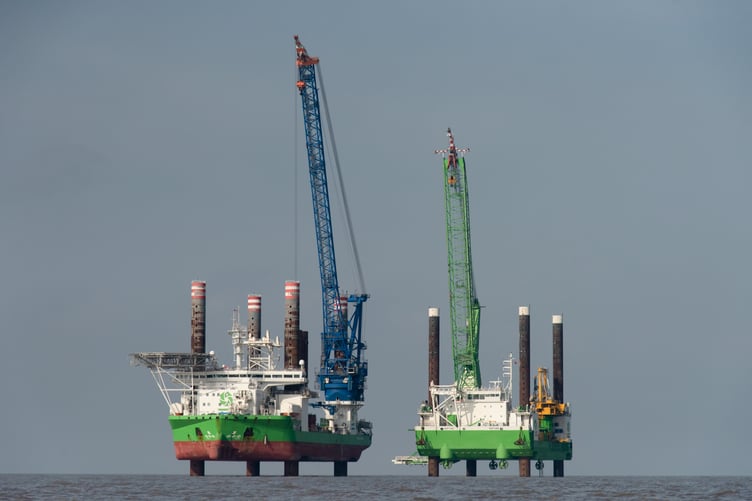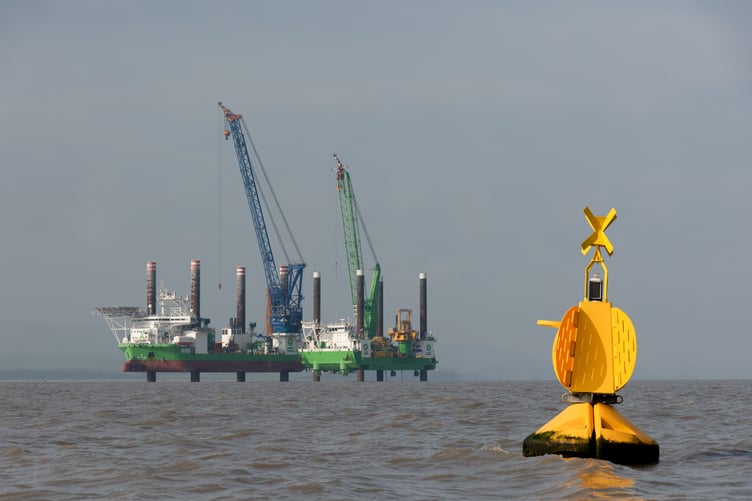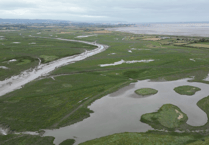THE final phase of off-shore work for the Hinkley Point C nuclear power station has begun with the arrival of two huge jack-up vessels.
The vessels, named ‘Neptune’ and ‘Sea Challenger’, are now off the West Somerset coast as the off-shore phase of the development moved into its final stages.
They will be used to install vital components for the power station’s cooling water system.
Six vertical shafts will be installed at a depth of more than 65 feet, marking the next stage in connecting six miles of tunnels with the seabed.
Once installed, miners will dig a horizontal connection between the bottom of the shaft and the tunnel, which is the first part of linking the intake and outfall heads with the tunnels.
The 5,000-tonne structures were lowered onto the seabed last summer and will circulate water to the two nuclear reactors.

Neptune and Sea Challenger can be seen off Hinkley Point C .
Cranes on the jack-up vessels, which have often been used to build off-shore wind farms, have a combined lifting capacity of 1,500 tonnes and ‘Sea Challenger’ also has a helideck.
At 433 feet, the ‘Sea Challenger’ is longer than a football pitch and can lift 900-tonnes, while ‘Neptune’ is 196 feet long and can lift 600-tonnes. Both vessels can accommodate 60 people.
Each vessel uses its four ‘legs’ to elevate itself above sea level so it can operate safely without being impacted by waves and currents.
Area delivery director Jonathan Smith said: “This is one of the final stages of our off-shore operations, which will see teams from EDF, Balfour Beatty, and New Wave Solutions working together to deliver yet another incredible feat of engineering.
“The cooling water system is critical to the power station, which will help Britain fight climate change and achieve stronger energy security.”
Balfour Beatty project director Roger Frost said: “The arrival of Neptune and Sea Challenger marks another significant step forward in the successful delivery of the first new nuclear power station in the UK for over 20 years.
“We now look forward to utilising our unique capability and unrivalled expertise to continue with the linking up of the six miles of tunnels which are buried below the Bristol Channel.
“This is another important chapter in the off-shore works required for Hinkley Point C’s critical water-cooling system.”
Work to install the shafts will continue into the autumn.
Hinkley C’s two European Pressurised Water Reactors (EPR) will eventually produce 3.2 gigawatts of electricity, enough to meet about seven per cent of the UK’s energy demand and power an average six million homes.
The first Hinkley reactor is due to start generating electricity by June, 2027, which is two years behind its original schedule, with the second reactor coming online a year later.
The Government’s Energy Security Strategy published last year says it wants to see the UK generating 24GW of nuclear electricity by 2050, about 25 per cent of the projected demand.
At present, nuclear provides about 18 per cent, but by the end of the decade only one of the country’s ageing stations will still be open.





Comments
This article has no comments yet. Be the first to leave a comment.